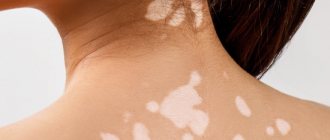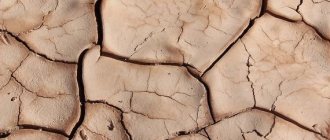Sometimes after sunbathing you may notice the appearance of white spots on the skin. Most people do not realize that this is a symptom of a skin disease.
At first, a person is bothered by itching and peeling of small areas of the skin, and after prolonged exposure to the sun, white spots appear on the arms, legs or chest. Most often, white spots on the skin are a sign that there is a fungal infection in the body. This is how pityriasis versicolor manifests itself.
When exposed to sunlight, healthy skin cells produce melanin, but the affected cells remain light-colored because they do not allow sunlight to pass through. Ringworm does not disappear on its own. At the first symptoms of tinea versicolor, you should consult a dermatologist.
What are the causes of pityriasis versicolor?
The causative agent of pityriasis versicolor is a conditionally pathogenic species of yeast that is constantly present on human skin and is part of its natural microflora.
The development of tinea versicolor occurs only under favorable conditions:
- genetic predisposition;
- increased sweating and changes in the chemical composition of sweat;
- frequent use of antibacterial gels;
- long-term treatment with steroid hormones;
- elevated blood sugar levels;
- weakened immunity;
- sun radiation (excessive tanning)
- diseases of the gastrointestinal tract, liver, pancreas;
- violations of skin barrier functions.
Most often, pityriasis versicolor occurs in young people, both men and women, but it also occurs in children with weak immunity, diabetes and vegetative neurosis. A separate risk group is children who experience excessive sweating during puberty. The likelihood of developing tinea versicolor is increased by solar radiation, heavy metals, and clothing made of synthetic materials.
What to do if your tan is patchy
As for diseases that give a “spotty tan,” everything is clear with them, people usually know about them, and if they allow the process to worsen, then they only have themselves to blame. But it happens that the spots appeared in people who were healthy in terms of skin diseases, which most likely extended their exposure to the sun or the time spent in the solarium.
Choose the perfect nail shape for yourself...
Much has been written about what time of day is most optimal for receiving ultraviolet treatments, what duration of exposure to the sun once, how many minutes to add daily, and how to deal with the sun for people who have naturally sensitive white skin , which quickly “burns” even in the shade. However, not everyone follows life-tested recommendations and then laments over a ruined tan.
Having received “spotting” after solar procedures, having visited a doctor and making sure that there is no disease, and the troubles happened due to one’s own lack of foresight, one can only wait for nature to restore the natural color over time.
You can even help her with this by using vitamin creams that moisturize and nourish the skin. Hot baths using a hard washcloth can help save the situation a little, rubbing with it you can exfoliate the upper layers of the epidermis.
If there is an urgent need to get rid of “spotting,” then a beauty salon serves this purpose. Specialist cosmetologists using laser and phototherapy will restore the natural color of the skin in just a couple of sessions, although the tan will probably need to be acquired again.
Is tinea versicolor contagious?
Not all infected people develop clinical signs of tinea versicolor, which is why it is classified as a conditionally infectious disease. Ringworm is transmitted through clothing, towels, and bedding. Pityriasis versicolor does not threaten human life, but at its first manifestations you should consult a dermatologist. If you do not pay attention to the symptoms and manifestations of the disease and do not start treatment, the spots on the skin will remain for a long time.
During treatment you should not visit beaches, swimming pools and baths. Rehabilitation involves general and individual measures for the treatment and prevention of pityriasis versicolor, intended for patients and people who may come into contact with them.
General measures to prevent ringworm:
- carrying out disinfection with chlorine-containing substances in public places (swimming pools, baths, saunas, sports facilities, industrial enterprises, etc.);
- sanitary educational work.
Individual treatment measures for ringworm:
- hygienic skin care;
- boiling linen and towels, ironing them;
- treatment of chronic diseases that can cause the appearance of tinea versicolor;
- individual drug treatment prescribed by a dermatologist.
How to get rid of white spots on skin
Methods for getting rid of white spots depend on the cause of their appearance. If the formations are the result of a violation of the basic rules of tanning, several sessions of sunbathing will be required in compliance with these rules; in other cases, it is necessary to use methods prescribed by a doctor.
Table: methods of dealing with white spots depending on the cause of their appearance
| Cause | How to get rid |
| Non-compliance with tanning rules |
|
| Burns |
|
| Increased sweating |
|
| Scar tissue | To remove a scar, the doctor may recommend: special products for external use, laser treatment or other resurfacing methods. During and for 1–2 months after therapy, it is prohibited to be in direct sunlight. |
| Taking certain medications | Avoid ultraviolet exposure during therapy and for a month after the course. |
| Vitiligo | Treatment uses individual therapy regimens, which may include:
If you have vitiligo, you cannot be in direct sunlight; the disease cannot be completely cured. |
| Guttate hypomelanosis | A complete cure is impossible; to slow down the formation of spots, the doctor may prescribe:
Sunbathing with guttate hypomelanosis is prohibited. |
| Pityriasis versicolor | Therapy is prescribed by a doctor, lasts 1–2 months and includes the use of external agents and oral medications. During treatment, it is useful to sunbathe, as ultraviolet radiation destroys yeast threads, preventing the appearance of new fungal cells. |
| Secondary syphilis | Depigmented areas completely restore their color after recovery as a result of therapy prescribed by a venereologist with antibacterial agents of the penicillin group. |
| Poikiloderma Siwatt | Treatment consists of using steroid medications prescribed by a doctor and eliminating factors that provoke the manifestation of the pathology, including exposure to UV rays. |
| Other malfunctions of the body | After the doctor has identified, based on the results of a thorough examination, the cause of the appearance of white spots, treatment is prescribed in accordance with the specific disease. |
What can you do at home?
Home methods will not help eliminate the cause of the appearance of white spots; only therapy prescribed by a doctor can do this. However, there are ways to make formations less noticeable. But this can only be achieved in one way - making the tan less pronounced. This result can be achieved either by accelerating the process of replacing melanin-filled cells with young ones (exfoliating procedures), or by using products with a brightening effect.
Any home methods can be used only after consulting a doctor and excluding the presence of infectious and viral diseases.
Speeding up tanning
Epidermal cells are constantly renewed; if you stop sunbathing, the chocolate tint of the skin will disappear after 4-5 weeks. However, this process can be accelerated:
- Steam exposure. Visiting baths, saunas, hammams and simply taking a bitter bath or shower stimulate the process of renewal of the epidermis.
- Using scrubs, hard washcloths and body brushes. Once a week, you can treat your body and face with a scrub: this will help exfoliate the upper, tanned particles of the epidermis. You can buy a ready-made product or make it yourself by mixing ground coffee beans, finely ground salt or cane sugar to a paste consistency with water, unrefined vegetable oil or shower gel. For the face, more delicate compositions are needed, for example, oatmeal mixed with cream in equal proportions. Hard washcloths and body brushes have a similar effect to scrubs.
Regular use of the scrub will speed up the process of lightening the tan, which will make the white spots less pronounced.
Lightening the skin
The intensity of the tan can be reduced by wiping the skin 1–2 times a day with compounds that have a lightening effect:
- juice of lemon, parsley, cucumber, raw potatoes;
- vinegar 9%, diluted with water in a ratio of 1 to 1;
- products with lactic acid (kefir, natural yogurt, yogurt);
- chamomile infusion (pour 2 tablespoons of raw material with a liter of boiling water, leave for 15–20 minutes, cool, strain).
To enhance the effect, you can use purchased cosmetics for the face and body containing components with brightening and regeneration-accelerating ingredients:
- acids (glycolic, fruit);
- tretinol;
- beta-carotene;
- vitamin B3;
- arbutin
The following products have proven themselves well among consumers:
- Natura Siberica “Black Currant” - night cream with a pleasant aroma and good composition;
- EO LABORATORIE “Brightening cream-serum” - contains plant extracts and oils, provides a good moisturizing and whitening effect, has a sun filter;
- Himalaya Herbals “Whitening Cream” - created on the basis of natural ingredients, including saffron and alfalfa extract, also lightens circles under the eyes;
- Secretkey, Snow White Moisture Cream - in addition to brightening, it gives a moisturizing effect and evens out skin tone;
- Skinolite “Whitening cream” - acts due to exfoliating and brightening effects;
- Holy Land, WHITENING PROTECTIVE MOIST - absorbs quickly, leaves no greasy residue, and has an unobtrusive aroma.
Whitening creams are designed to combat pigmentation, but they are also suitable for lightening the skin. Since most products contain acids, it is not recommended to use them for more than 1-2 weeks in a row. It is best to consult a cosmetologist or dermatologist before choosing a suitable product.
Why shouldn’t pityriasis versicolor be treated with traditional methods?
Self-medication is dangerous to health; you should not prescribe medications to yourself or use traditional methods of treatment - this can worsen the condition of the skin and aggravate the development of the disease. Only a dermatologist can determine the exact type of infection and its nature and help choose treatment to eliminate the symptoms.
If you feel discomfort on the skin in the arms, legs or chest, you should consult a dermatologist. If you strictly follow the instructions, you will be convinced that the fungus on the skin can be treated.
Types of solariums
Currently, beauty salons and other similar establishments offer visitors three types of solariums:
- Horizontal - a classic option that involves insolation in a lying position. It is ideal for people who want not just to get a tan, but to take a break from endless worries and relax.
- Vertical - traditionally equipped with high-power lamps, allowing you to reduce session time without compromising the quality of tanning. You have to stand in such a solarium, but, as many clients note, this does not create discomfort. However, in order for the tan to apply evenly, you need to turn.
- Turbo solarium is equipped with a special air conditioning system that prevents burns and makes staying inside the capsule more comfortable. Solariums of this type may differ in the type of placement, but the result is always the same - a rich, uniform tan.
Choosing a solarium is a personal matter for everyone, but to determine the best one for yourself, it’s worth sunbathing in each one. You should also study the pros and cons of all options, and only then draw conclusions.
Benefits and harms
Assuring that tanning in a solarium is solely beneficial or harmful is wrong, although there is a lot of controversy surrounding this. In fact, this procedure has negative and positive sides, which we will discuss in more detail.
Why does my tan fade in patches?
By covering an improperly sunbathing person with spots, “the sun is trying to teach a lesson for the future.” If people know why the tan fades in patches, and have experienced it the hard way, then for the next “brown” season they will not only draw up a program for taking ultraviolet procedures, but will also tell their friends and acquaintances about it, because they now know why it fades spots.
And the tan behaves this way because the owner of the body blocked access to melanocytes in these areas, thereby creating an obstacle to the production of melanin, which was actively produced in other places, covering the skin with a “chocolate” tan. Uneven distribution of melanin is the cause of spotting, and fading of spots is already a consequence. It would probably be useful to have some recommendations for those who neglected them before and paid for it:
- start forming a beautiful tan within 5-10 minutes (for the first time it’s enough for the skin to get used to it and “tune in”);
- daily tanning time should be 20-25 minutes, half an hour is the maximum;
- You need to go out into the sun at certain times of the day: in the morning - 9-10 o'clock or after 4 o'clock in the afternoon. Noon is considered the most unfavorable period for contact with the sun, so it is better to spend it in the shade or indoors;
- do not forget about protection from scorching rays with the help of a cream, which should be applied after each bath, even if the instructions say that it is waterproof.
Performing simple manipulations will protect those who forget that a beautiful tan in other cases can cause troubles that can be delayed over time, that is, what seems like an unnoticeable trifle in youth can turn into a problem a few years later. Intense tanning without skin protection leads to dryness and premature aging, therefore, having beautiful velvety skin, you need to remember this and take care of it.
.
- 1 Comment
- « How to quickly grow eyebrows
- Causes of acne on the face »








